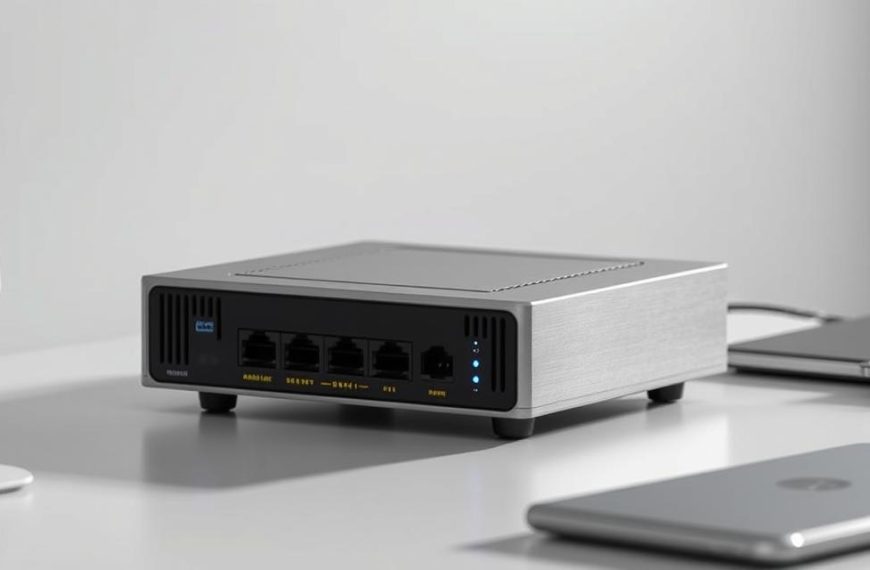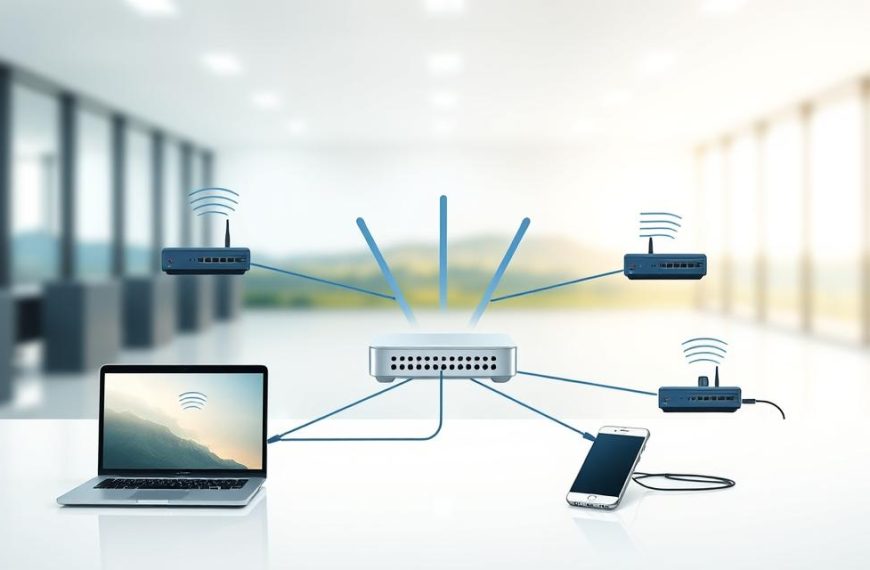The Transmission Control Protocol (TCP) and User Datagram Protocol (UDP) are two fundamental protocols in the transport layer of computer networks. While both play crucial roles in data transfer, they differ significantly in their approaches to data transmission.
TCP prioritises reliability and ensures that data packets are delivered in the correct order, making it suitable for applications requiring guaranteed delivery. On the other hand, UDP focuses on speed and is often used for applications where fast data transfer is more critical than reliability.
Understanding the distinction between these protocols is vital for network engineers and IT professionals involved in designing or managing network communications. This article will delve into the mechanisms of TCP and UDP, highlighting their strengths and weaknesses to help readers choose the appropriate protocol for specific network scenarios.
The Fundamentals of Network Protocols
In the realm of computer networks, protocols serve as the standardised rules that dictate how data is communicated. These rules are essential for enabling devices to exchange information seamlessly across various network environments.
The OSI Model and Transport Layer
The OSI model is a conceptual framework that standardises communication functions into seven layers. The Transport Layer, Layer 4, is particularly crucial as it ensures reliable data transfer between devices. This layer is where Transmission Control Protocol (TCP) and User Datagram Protocol (UDP) operate, governing how data is broken down into packets, addressed, and reassembled.
| Layer | Function | Protocols |
|---|---|---|
| 4 | Transport | TCP, UDP |
| 3 | Network | IP |
The Role of Protocols in Data Transmission
Protocols determine how information is formatted, transmitted, received, and acknowledged between devices on a network. They establish the “language” that networked devices use to communicate, ensuring that different systems can understand each other regardless of their underlying hardware or software. The sender and receiver rely on these protocols to ensure that data packets are delivered correctly.
By governing the flow of data, protocols play a critical role in ensuring reliable, efficient, and secure data transmission. Understanding the role of protocols provides a foundation for grasping why different protocols are needed for different types of network communications and data transmission requirements.
What is UDP and TCP in Computer Network
Data transmission over the internet is primarily governed by two protocols: Transmission Control Protocol (TCP) and User Datagram Protocol (UDP). These protocols are fundamental to understanding how data is exchanged between devices on a network.
Transmission Control Protocol (TCP) Defined
TCP is a connection-oriented protocol that ensures reliable data transfer between devices. It establishes a connection before data is sent, guarantees delivery, and ensures that data packets are received in the correct order. This reliability is crucial for applications where data integrity is paramount, such as file transfers and email communications.
Reliable Data Transfer: TCP’s reliability is achieved through mechanisms like error-checking and retransmission of lost packets. This makes it suitable for applications that cannot tolerate data loss.
User Datagram Protocol (UDP) Defined
UDP, on the other hand, is a connectionless protocol that prioritizes speed over reliability. It does not establish a connection before transmitting data, which results in faster but potentially less reliable data transfer. UDP is used in applications where speed is critical, and some data loss is tolerable, such as online gaming and video streaming.
Key Characteristics of UDP:
- Connectionless, reducing overhead and increasing speed
- No guarantee of delivery or order of packets
- Suitable for real-time applications where some data loss is acceptable
A comparison of TCP and UDP highlights their different approaches to data transmission. The following table summarizes their key differences:
| Protocol | Reliability | Speed | Connection |
|---|---|---|---|
| TCP | High | Relatively Slow | Connection-Oriented |
| UDP | Low | Fast | Connectionless |
As noted by networking experts, “UDP’s simplicity and low overhead make it an attractive choice for applications that require fast and efficient data transfer, even if it means sacrificing some reliability.”
“The choice between TCP and UDP depends on the specific requirements of the application or service in question.”
Connection Methods: The Core Difference
A key distinction between TCP and UDP is their respective connection-oriented and connectionless methodologies. This fundamental difference significantly impacts their application and functionality in computer networks.
TCP’s Connection-Oriented Approach
TCP employs a connection-oriented approach, establishing a dedicated connection between the sender and receiver before data transmission begins. This involves a handshake process to ensure both parties are ready to communicate. Once the connection is established, data is transmitted in a sequential manner, guaranteeing that packets are received in the correct order. This approach ensures reliability but introduces additional overhead due to connection establishment, maintenance, and termination.
UDP’s Connectionless Mechanism
UDP, on the other hand, utilises a connectionless protocol, transmitting data without first establishing a dedicated connection. It sends datagrams or packets to the destination address without verifying whether the recipient is ready or even exists. This “fire and forget” methodology eliminates the overhead associated with connection management, significantly reducing latency and making UDP ideal for time-sensitive applications where occasional packet loss is acceptable.
UDP’s connectionless nature makes it particularly efficient for broadcast and multicast transmissions, where data needs to be sent to multiple recipients simultaneously. The efficiency in transmission and reduced overhead contribute to UDP’s suitability for applications requiring speed.
Reliability and Error Handling
Error handling and reliability mechanisms vary significantly between UDP and TCP, impacting their suitability for different applications.
TCP’s Error Checking and Recovery
TCP is renowned for its robust error checking and recovery capabilities. It ensures that data is delivered reliably by using sequence numbers, acknowledgments, and retransmission of lost or corrupted packets. This process guarantees that the data received is accurate and complete, making TCP suitable for applications where data integrity is paramount.
The error checking in TCP involves verifying the integrity of the data being transmitted. If a packet is found to be corrupted or lost, TCP requests retransmission, ensuring that the data is delivered correctly. This retransmission capability is a key feature that distinguishes TCP from UDP.
UDP’s Basic Error Detection
In contrast, UDP employs a more basic approach to error detection. It uses checksums to verify the integrity of the datagram. However, if a UDP packet fails the checksum verification, it is simply discarded without any request for retransmission. This approach prioritizes speed over reliability, making UDP suitable for real-time applications where the timely delivery of data is more critical than its accuracy.
UDP’s lack of sequence numbers, acknowledgments, and retransmission capabilities means that it does not guarantee the delivery of data packets. This minimal error handling contributes to UDP’s efficiency and low latency, making it ideal for applications such as video streaming and online gaming, where occasional data loss is preferable to delays.
| Feature | TCP | UDP |
|---|---|---|
| Error Checking | Robust, with retransmission | Basic, using checksums |
| Reliability | High, guarantees delivery | Low, no guarantee of delivery |
| Application Suitability | File transfers, email | Real-time applications, streaming |
Speed and Performance Comparison
Understanding the speed and performance implications of choosing between TCP and UDP is vital for optimising network communications. The choice between these two protocols depends on the specific requirements of the application or service being delivered.
Why UDP Offers Faster Transmission
UDP is generally faster than TCP due to its connectionless nature and lower overhead. Unlike TCP, UDP does not establish a connection before data transfer, nor does it guarantee delivery. This results in faster transmission as there are no acknowledgment packets or retransmissions to slow down the process.
One key factor contributing to UDP’s speed is its simpler header structure, which contains less metadata compared to TCP. With a fixed header size of 8 bytes, UDP reduces the amount of overhead data transmitted with each packet, improving bandwidth utilisation.
TCP’s Speed Trade-offs for Reliability
TCP, on the other hand, prioritises reliability over speed. Its larger header size, which can range from 20 to 60 bytes, increases the overhead data transmitted with each packet. This, combined with TCP’s acknowledgment system and retransmission of lost packets, introduces delays that can impact overall performance.
TCP’s congestion control mechanisms also deliberately slow down transmission rates when network congestion is detected, further affecting its speed. The table below summarises the key differences in speed and performance between TCP and UDP.
| Protocol | Header Size | Reliability | Speed |
|---|---|---|---|
| TCP | 20-60 bytes | High | Slower |
| UDP | 8 bytes | Low | Faster |
In conclusion, while TCP sacrifices some speed for the sake of reliability, UDP’s faster transmission makes it suitable for applications where real-time delivery is critical.
Header Structure and Overhead
The structure of headers in network protocols significantly impacts data transmission efficiency. Both TCP and UDP have distinct header structures that reflect their different design philosophies and application requirements.
TCP Header Components
The TCP header is more complex, with a variable length ranging from 20 to 60 bytes. It includes several crucial fields such as source and destination ports, sequence and acknowledgment numbers, and various control flags. These components enable TCP’s reliable, connection-oriented service, allowing for data reassembly, error detection, and flow control. The variable length accommodates optional features, but this flexibility comes at the cost of increased processing requirements and header overhead.
UDP’s Lightweight Header
In contrast, UDP boasts a remarkably simple and lightweight header, fixed at 8 bytes. It comprises four essential fields: source port, destination port, length, and checksum. This minimalist design minimises processing requirements and data overhead, making UDP particularly suited for applications where speed is paramount, such as real-time media streaming and online gaming. UDP’s datagram structure allows for efficient transmission of packets, albeit with less control over delivery and integrity. For more information on the differences between TCP and UDP, visit GeeksforGeeks.
UDP’s header design reflects its fundamental philosophy of prioritising speed and efficiency over reliability and control. By keeping the header overhead to a minimum, UDP enables faster transmission of data packets, which is critical for applications requiring low latency.
Applications and Use Cases
Different applications have different needs when it comes to network protocols, with UDP and TCP serving distinct purposes. The choice between these protocols largely depends on the specific requirements of the application, such as the need for reliability, speed, or low latency.
Ideal Scenarios for TCP Implementation
TCP is the preferred protocol for applications that require guaranteed delivery of data. This includes file transfers, email communications, and web browsing. For instance, when downloading a file, TCP ensures that the data is delivered reliably and in the correct order, making it suitable for applications where data integrity is paramount.
TCP’s reliability features, such as error checking and recovery, make it an ideal choice for applications that cannot tolerate data loss. For example, in financial transactions, TCP ensures that data is transmitted accurately and reliably, which is critical for maintaining the integrity of financial records.
When UDP is the Preferred Choice
UDP, on the other hand, is suited for applications that prioritise speed over reliability. This includes real-time multimedia streaming, online gaming, and VoIP. For instance, in video streaming services, UDP’s low-latency nature ensures smooth playback, even if occasional data loss occurs.
Online gaming is another area where UDP is preferred due to its ability to facilitate fast communication between players. The responsiveness of gameplay is crucial, and UDP’s connectionless mechanism helps achieve this by minimising latency. Additionally, UDP is used in network management protocols like DNS queries, SNMP, and DHCP, where quick request-response cycles are more important than guaranteed delivery.
Advantages and Disadvantages
To make informed decisions about network protocols, it’s essential to examine the pros and cons of both TCP and UDP. This analysis will help in understanding which protocol is best suited for specific applications.
TCP: Pros and Cons
TCP offers several advantages, including reliable data transfer and error-checked delivery. Its connection-oriented approach ensures that data packets are delivered in the correct order, making it suitable for applications that require high data integrity, such as file transfers and email.
However, TCP’s reliability mechanisms come at the cost of increased latency and overhead due to its three-way handshake and acknowledgment packets. This makes TCP less suitable for real-time applications that require low latency.
UDP: Pros and Cons
UDP has several key advantages, including low latency and minimal overhead, making it ideal for real-time applications such as video streaming and online gaming. UDP’s connectionless mechanism allows for faster data transmission without the need for establishing a connection.
However, UDP’s lack of delivery guarantees and packet ordering makes it less reliable than TCP. UDP is also vulnerable to network congestion and has limited error recovery capabilities, which can result in packet loss.
In summary, while UDP offers performance benefits, its reliability trade-offs must be carefully considered, especially in applications where data integrity is crucial.
Real-World Protocol Examples
The internet relies on various protocols to function efficiently, with TCP and UDP being two of the most fundamental. These protocols are used in a wide range of applications and services, each chosen for its specific characteristics.
TCP-Based Services and Protocols
TCP is widely used for applications that require guaranteed delivery of data. For example, file transfer protocol (FTP) uses TCP to ensure that files are transferred reliably between servers and clients. Web browsing also primarily uses TCP, as it ensures that web pages are loaded completely and in the correct order. Email services, including SMTP (Simple Mail Transfer Protocol), rely on TCP for the reliable transmission of email messages.
Additionally, many remote access protocols, such as SSH (Secure Shell), use TCP to provide a secure and reliable connection between the client and server. These examples demonstrate TCP’s importance in applications where data integrity is paramount.
UDP-Based Services and Protocols
UDP, on the other hand, is used by applications that prioritise speed over reliability. 
Furthermore, VoIP (Voice over Internet Protocol) and video conferencing platforms, such as Zoom and Microsoft Teams, utilise UDP to reduce latency in real-time communications. These examples highlight UDP’s suitability for applications where speed is critical.
Conclusion: Choosing Between TCP and UDP
Ultimately, understanding the differences between TCP and UDP is crucial for determining which protocol is best suited for a particular use case. The choice between these two fundamental Transport Layer protocols depends on the specific requirements of the application or service being used.
TCP offers dependable, orderly, and error-free data transmission, making it ideal for operations that require precision, such as file transfers and web browsing. On the other hand, UDP provides quicker, connectionless communication that is excellent for real-time applications like gaming and video streaming, where speed is critical and minor data loss is acceptable.
When deciding between TCP and UDP, one must consider factors like reliability needs, latency sensitivity, bandwidth constraints, and scalability concerns. Emerging protocols like QUIC aim to combine TCP’s reliability with UDP’s speed, addressing specific networking challenges.
In summary, both TCP and UDP are vital for different data transfer scenarios, and their usage is dictated by the nature of the data being communicated and the priorities of the application. By understanding their differences, developers can make informed decisions about which protocol to use for their specific needs.















